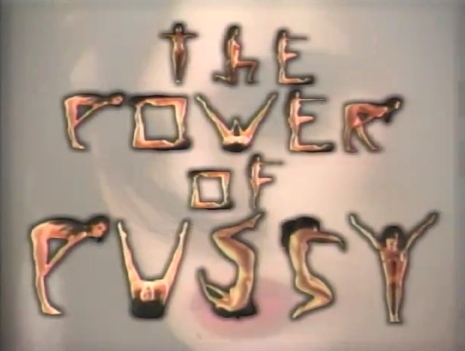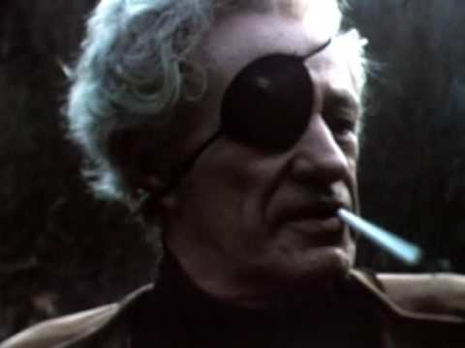
Behold the rarely seen music video for Bongwater’s feminist indie rock anthem, The Power of Pussy, from the album of the same title.
When The Power of Pussy came out, in 1991, I became obsessed with doing a music video for this song. I was, and still am, a huge, huge Bongwater fan. Luckily, at the time, I was working at the studio where Ann Magnuson’s Cinemax special Vandemonium had been produced and one of the partners knew Ann and introduced me to her. Ann and I have been great friends ever since. (Bongwater’s Kramer and I went on to author a screenplay together, a conspiracy theory comedy about homicidal mailmen, called Mailman, which we’re going to adapt into a graphic novel one day).
Partnering with a friend of mine named Alan Henderson, I had been working on various low budget music videos for a couple of years—-mostly for “underground” and indie acts from New York’s East Village. We’d shoot and edit them in the Manhattan-based Windsor Digital Video post production house where we both worked, off hours and on the weekends. The highest budget we ever got was, I think, $3000. (This Bongwater video had a budget of $1000 and $600 of that went to Ann’s hair and make-up, with the remainder going to pizza and videotape stock.). We did videos for John Sex, two for Larry Tee, one for an absolutely brilliant band called The Beme Seed, whose lead singer was Kathleen Lynch, the naked, gyrating go-go dancer from deep within the bowels of Hell who made the live Butthole Surfers experience so deeply berserk in the mid-80s. I’m going to post them all here in the coming week.
I had just left this job at the post house and had taken a new gig downtown at this production studio when this was in the planning stages. One of the principal animators in the studio, Glen Claybrook (who had projects like Pee-wee’s Playhouse and the opening credits for Madonna’s Who’s That Girl film under his belt) came up to me one day and said “Hey, I hear you are going to do a video for Bongwater’s Power of Pussy and I have had a vision….”
That, as you will see from the animation Glen produced, was a coy understatement! A vision, indeed! The best thing was, we didn’t pay a single cent cent for any of the animation costs because it was all shot on 35mm short ends and was processed, transfered and charged off to a huge advertising agency’s budget. We probably buried about two grand of the costs in that way. Sometimes you have to be a little creative, right? It never would have happened otherwise.
And speaking of getting creative, we also needed, to be able to pull off the title, as seen above, a woman who wasn’t shy about getting naked. I’ve read on the Internet that she is supposed to be Christina Martinez from Boss Hog (and wife of Jon Spencer) but this is inaccurate. It’s a good guess, it’s just not true. We found the performer for this, a woman with the first name Gina, at the New York Dolls topless bar near Wall Street. As you can see from the video, she was staggeringly beautiful. When she would change stages, as dancers tend to do, the entire gravity of the room would shift as every guy in the house moved across the floor, clamoring to get a better look. She was Megan Fox hot. Probably made $5000 a day in tips, which she spent on putting herself through medical school as I recall.
The feral felines were shot on Elizabeth Street in Little Italy. An eccentric old lady fed dozens of stray cats and someone I knew suggested that I just needed to show up with a few soup bones to see them totally go nuts. And they did indeed (see video). I shot that part on Super 8.
In the end, as will come as no surprise to anyone, this video got played very, very, very few times in public: twice on Playboy’s Hot Rocks (a music video show hosted by Jenny McCarthy and produced by my old friend Eric Mittleman) and once on Al Goldstein’s Midnight Blue cable access program when Bongwater’s Kramer was a guest on the show). It’s in the permanent collection of 17 museums around the world (mostly in former Soviet client states, believe it or not, but one is in California).
Ann threw a big party to premiere the video and it was the first time I was ever in Los Angeles. There were tons of TV and movie stars there (Albert Brooks, Richard Lewis), rockstars (members of Red Hot Chili Peppers and Fishbone) Russ Meyer actress Kitten Natividad and even Simpson’s creator Matt Groening, who asked me for a copy for his personal collection, which was a thrill. (When his wife arrived at the party he even made me play it a second time). The party was written up in the LA Weekly. It was my first evening in Los Angeles and that night I decided I wanted to move here and did, six months later.
I haven’t seen this video in years, but today Eric made a digital copy for me from the sole tape I have of this piece—a 3/4” tape, I might add—and I laughed my ass off watching it. Now it’s your turn… Enjoy!
Credits, as I recall them after 19 years… Directed by Alan Henderson and Richard Metzger. Animation directed by Glen Claybrook. Produced by me, and shot and edited by Alan. Billy Beyond did Ann’s make-up and Danilo did that ‘leaning tower of wig’ that Ann’s wearing (she had worn this same wig the week before in London, giving an award to ZZ Top(!) with Justin Hayward and John Lodge of Moody Blues on the Brit Awards program). Thanks would be appropriate also to Peter Rosenthal who helped shepherd this through the production process as cheaply as possible via his former production company.








